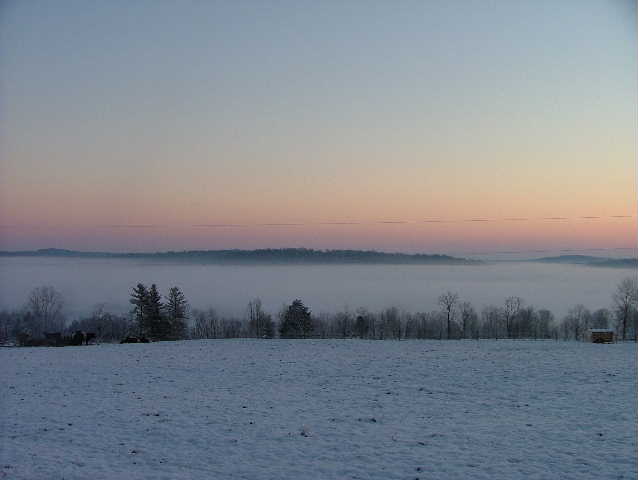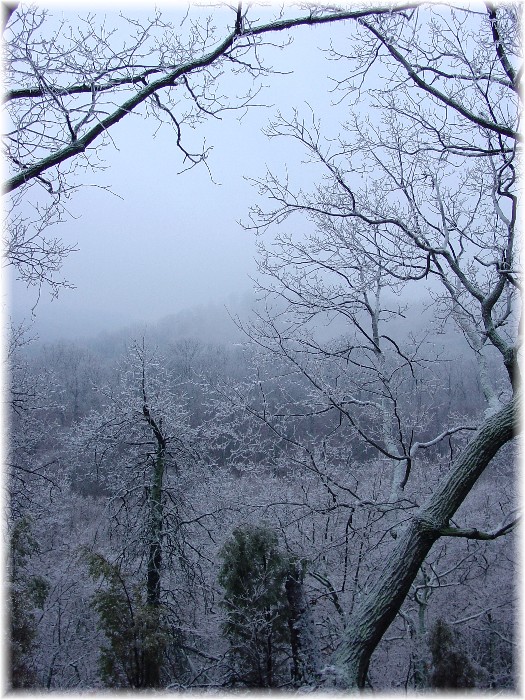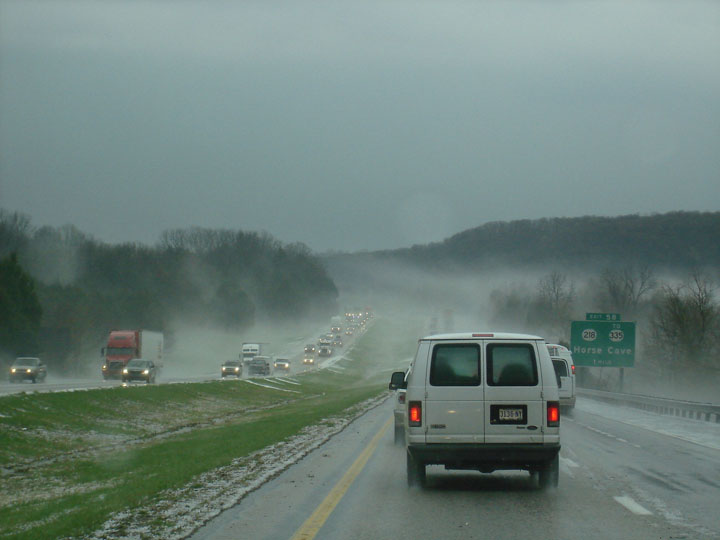Radiation Fog
This type of fog forms at night under clear skies with calm winds when heat absorbed by the earth’s surface during the day is radiated into space. As the earth’s surface continues to cool, provided a deep enough layer of moist air is present near the ground, the humidity will reach 100% and fog will form. Radiation fog varies in depth from 3 feet to about 1,000 feet and usually remains stationary. This type of fog can reduce visibility to near zero at times and make driving very hazardous.
Valley fog is a type of radiation fog. When air along ridgetops and the upper slopes of mountains begins to cool after sunset, the air becomes dense and heavy and begins to drain down into the valley floors below. As the air in the valley floor continues to cool due to radiational cooling, the air becomes saturated and fog forms. Valley fog can be very dense at times. This type of fog tends to dissipate very quickly once the sun comes up and starts to evaporate the fog layer.
 |
| Valley fog in Harrison County, Indiana. Scott Taylor |
Advection Fog
Advection fog often looks like radiation fog and is also the result of condensation. However, the condensation in this case is caused not by a reduction in surface temperature, but rather by the horizontal movement of warm moist air over a cold surface, such as warm moist air flowing over snow. Advection fog can sometimes be distinguished from radiation fog by its horizontal motion along the ground.
|
|
| Fog invading downtown Louisville from the Ohio River. WHAS |
Freezing Fog
Freezing fog occurs when water droplets remain in the liquid state until they come into contact with a surface upon which they can freeze. As a result, any object the freezing fog comes into contact with will become coated with ice.
 |
| Freezing fog in Jefferson Memorial Forest. Tony Bright |
Evaporation or Mixing Fog
This type of fog forms when sufficient water vapor is added to the air by evaporation and the moist air mixes with cooler, relatively drier air. The two common types are steam fog and frontal fog. Steam fog forms when cold air moves over warm water. When the cool air mixes with the warm moist air over the water, the moist air cools until its humidity reaches 100% and fog forms. This type of fog takes on the appearance of wisps of smoke rising off the surface of the water.
The other type of evaporation fog is known as frontal fog. This type of fog forms when warm raindrops evaporate into a cooler drier layer of air near the ground. Once enough rain has evaporated into the layer of cool surface, the humidity of this air reaches 100% and fog forms.
Hail Fog
Hail fog is an unusual type of fog that forms shortly after a heavy hailstorm. The cold balls of ice fall into warm, very moist air near the surface. As the hail accumulates on the ground, it cools the air just above the ground to the dew point, resulting in fog. The fog forms when winds are light, and it usually quite patchy and shallow.
 |
| Hail fog along Interstate 65 near Horse Cave, Kentucky. Brian Fugiel |
Remember, whenever you drive into dense fog ALWAYS slow down. This will allow you to increase the distance between your car and any cars in front of you that you may not be able to see due to the thickness of the fog. It is also important to switch your headlights to low beams.
This page was developed in conjunction with NWS Jackson Kentucky